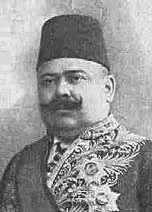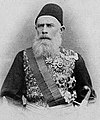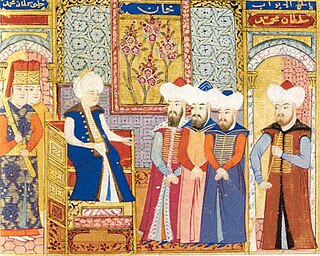
Mehmed I, also known as Mehmed Çelebi or Kirişçi, was the Ottoman sultan from 1413 to 1421. The fourth son of Sultan Bayezid I and Devlet Hatun, he fought with his brothers over control of the Ottoman realm in the Ottoman Interregnum (1402–1413). Starting from the province of Rûm he managed to bring first Anatolia and then the European territories (Rumelia) under his control, reuniting the Ottoman state by 1413, and ruling it until his death in 1421. Called "The Restorer," he reestablished central authority in Anatolia, and he expanded the Ottoman presence in Europe by the conquest of Wallachia in 1415. Venice destroyed his fleet off Gallipoli in 1416 as the Ottomans lost a naval war.
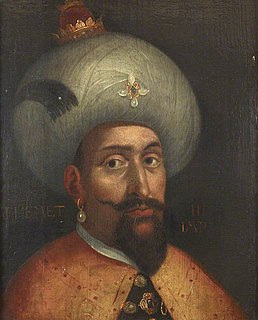
Mehmed III was Sultan of the Ottoman Empire from 1595 until his death in 1603. Mehmed was known for ordering the execution of his brothers and leading the army in the Long Turkish war, during which the Ottoman army was victorious at the decisive Battle of Keresztes. This victory was however undermined by some military losses such as in Gyor and Nikopol. He also ordered the successful quelling of the Jeleli rebellions. The sultan also communicated with the court of Elizabeth I on the grounds of stronger commercial relations and in the hopes of England to ally with the Ottomans against the Spanish.

Mahmud II was the 30th Sultan of the Ottoman Empire from 1808 until his death in 1839.
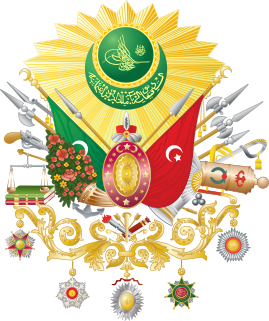
The Tanzimat was a period of reform in the Ottoman Empire that began with the Gülhane Hatt-ı Şerif in 1839 and ended with the First Constitutional Era in 1876.

Mehmed Fuad Pasha, sometimes known as Keçecizade Mehmed Fuad Pasha and commonly known as Fuad Pasha, was an Ottoman administrator and statesman, who is known for his prominent role in the Tanzimat reforms of the mid-19th-century Ottoman Empire, as well as his leadership during the 1860 Mount Lebanon civil war in Syria. He represented a modern Ottoman era, given his openness to European-style modernization as well as the reforms he helped to enact.
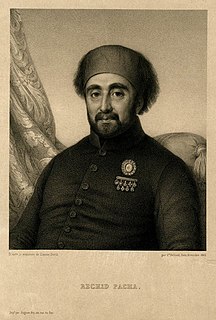
Koca Mustafa Reşid Pasha was an Ottoman statesman and diplomat, known best as the chief architect behind the Ottoman government reforms known as Tanzimat.
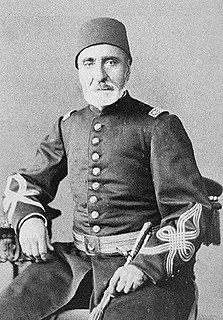
The Ottoman Empire used anthems since its foundation in the late 13th century, but did not use a specific imperial or national anthem until the 19th century. During the reign of Mahmud II, when the military and imperial band were re-organized along Western European lines, Giuseppe Donizetti was invited to head the process. Donizetti Pasha, as he was known in the Ottoman Empire, composed the first Western European-style imperial anthem, the Mahmudiye Marşı.

Mehmed Emin Âli Pasha, also spelled as Mehmed Emin Aali was a prominent Ottoman statesman during the Tanzimat period, best known as the architect of the Ottoman Reform Edict of 1856, and for his role in the Treaty of Paris (1856) that ended the Crimean War. Âli Pasha was widely regarded as a deft and able statesman, and often credited with preventing an early break-up of the empire.
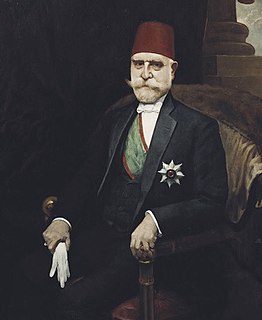
Damat Mehmed Ali Pasha (1813–1868) was an Ottoman statesman and diplomat. He served as the Grand Vizier from October 3, 1852, to May 14, 1853, on the eve of the Crimean War. Along with Fuad Pasha, Mehmed Emin Âli Pasha and Mustafa Reşid Pasha, he was one of the main reformers of the Tanzimat period.

Abdulmejid I was the 31st Sultan of the Ottoman Empire and succeeded his father Mahmud II on 2 July 1839. His reign was notable for the rise of nationalist movements within the empire's territories. Abdulmejid wanted to encourage Ottomanism among secessionist subject nations and stop rising nationalist movements within the empire, but despite new laws and reforms to integrate non-Muslims and non-Turks more thoroughly into Ottoman society, his efforts failed in this regard.
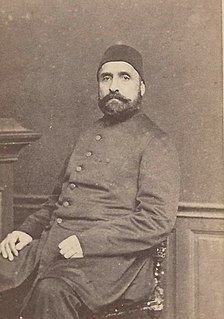
Mehmed Rushdi Pasha was an Ottoman reformist and statesman. He served as Grand Vizier of the Ottoman Empire during five separate terms. He was preceded by Midhat Pasha. Mehmed Rushdi Pasha was a fervent supporter of the Tanzimat. He believed that the empire would lag behind the West if no attempt was made to modernize itself. He served as a Translator of Military texts as well as a military colonel in his youth. He was born in 1811, and died on 27 March 1882.

Yusuf Kamil Pasha was an Ottoman statesman and Grand Vizier of the Ottoman Empire during the reign of Sultan Abdülaziz.

Seniha Sultan was an Ottoman princess, the daughter of Sultan Abdulmejid I and Nalandil Hanım. She was the half-sister of Sultans Murad V, Abdul Hamid II, Mehmed V, and Mehmed VI.
Saliha Sultan was an Ottoman princess, the daughter of Sultan Mahmud II and Aşubcan Kadın. She was the half-sister of Sultans Abdulmejid I and Abdulaziz.
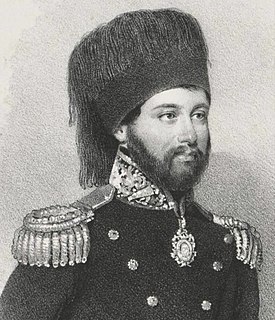
Damat Gürcü Halil Rifat Pasha, was an Ottoman admiral and statesman of Georgian origin. He served in the periods of Mahmud II and Abdulmejid I.
The Ministry of Foreign Affairs was the department of the Imperial Government responsible for the foreign relations of the Ottoman Empire, from its establishment in 1836 to its abolition in 1922. Before 1836, foreign relations were managed by the Reis ül-Küttab, who was replaced by a Western-style ministry as part of the Tanzimat modernization reforms. The successor of the Ottoman Ministry of Foreign Affairs is the Ministry of Foreign Affairs of the Turkish Republic.
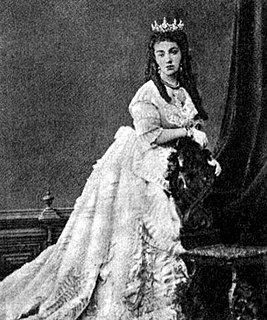
Refia Sultan was an Ottoman princess, daughter of Sultan Abdulmejid I and his sixth wife Gülcemal Kadın. She was full sister of Sultan Mehmed V of the Ottoman Empire.
Mihrimah Sultan was an Ottoman princess, the daughter of Sultan Mahmud II, and his fourth wife Hoşyar Kadın. She was the half-sister of Sultans Abdulmejid I and Abdulaziz.
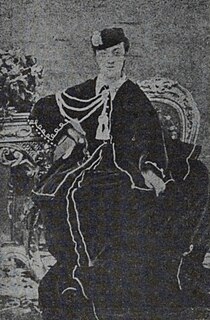
Hayriye Hanımsultan was an Ottoman princess, the daughter of Damat Mehmed Ali Pasha and Adile Sultan.
